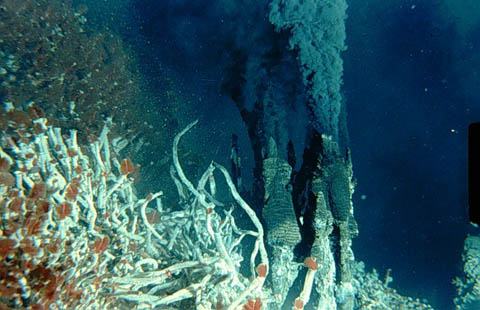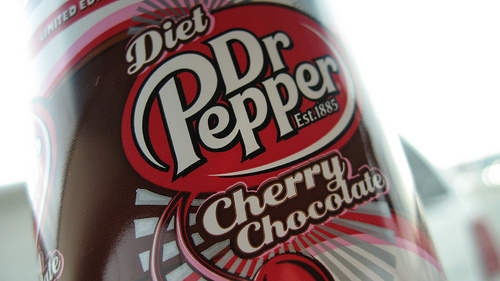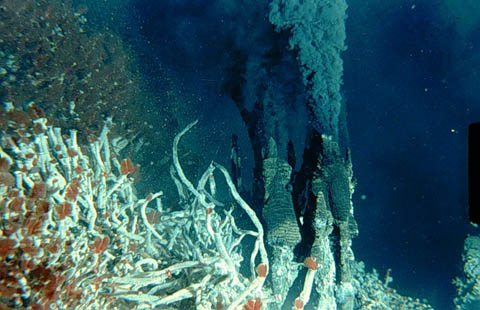 The biome around a hydrothermal vent is truly like nothing on the planet, because most candy-ass living creatures can’t hack it in such a hot, sunless, sulfurous environment. But even though it’s inhospitable, it may actually be where life began on earth. None of this, of course, will stop mining companies from reaming the vents out in order to dredge up some metal they could find in the trash.
The biome around a hydrothermal vent is truly like nothing on the planet, because most candy-ass living creatures can’t hack it in such a hot, sunless, sulfurous environment. But even though it’s inhospitable, it may actually be where life began on earth. None of this, of course, will stop mining companies from reaming the vents out in order to dredge up some metal they could find in the trash.
The critters that live around these vents are basically undersea aliens: Before he was the Avatar guy, James Cameron directed a film about these suckers. We’re talking not only crazy crap like giant tubeworms, but also the aptly-named extremophiles: single-celled organisms so tough they live inside volcanoes, eat ammonia for breakfast, and basically go around being the Chuck Norris of microbes.
Unfortunately, the real-life alien creatures are also living on top of a load of unobtanium, i.e. minerals like copper, zinc, silver, and gold. Mining these resources would mean cutting, dredging, and drilling into the seafloor, disrupting the ecosystem and making the whole place look basically like … well, like a strip mine. Call it seafloor removal. Even extremophiles want nothing to do with that shiz.
Cindy Van Dover, a scientist at Duke, published a piece last week in Nature calling for regulations on undersea mining. A company called Nautilus Minerals has a 20-year lease from the government of Papua New Guinea to “commence open-cut mining of Solwara 1 within the next few years, removing mineral ores (and organisms) to an estimated depth of 20-30 metres [66-90 feet] over an area equivalent to about 10 football fields,” says Dover.
Nautilus has set aside an equivalent amount of seafloor for “repopulation,” which is certain to be a raging success. Uprooting a unique ecosystem distinctly suited to its strange geological environment and putting it somewhere else — what could go wrong? You only have to look at the hopelessness of “restoration” projects after mountaintop removal to get a sense of how well a post-mining Frankenvent is likely to function.
Not only are giant tracts of seafloor under threat, but nobody really knows how mining will affect the ecology down there:
There are three scientific reasons for deferring wholesale commercial mining until proper conservation plans are enacted. First, there is much more to learn about hydrothermal vent systems. After three decades of work, researchers continue to find new vent sites in remote locations and new species, adaptations, behaviours and microhabitats, even in well-known settings.
Second, there is no strategy in place to assess the cumulative impacts of mining. Mining one vent field may be comparable to a volcanic eruption or other natural process that wipes out vent communities …
Third, we still don’t know how best to mitigate mining activities or to restore habitats in the deep sea.
Van Dover wants the International Seabed Authority to institute conservation policies before granting mining licenses. Maybe “no mining licenses” would be a better bet, since the ISA has the dubious honor of handling both leasing and environmental responsibilities at the same time. In other words, the agency that grants mining licenses might be totally ecologically responsible! And extremophiles might fly out of my butt.
It’s not like we actually need to jack up the ocean floor in order to get these metals. With a little elbow grease most of them can be picked out of electronic waste — hey, they did it for the Olympics.
If you venture to the outskirts of any major city, you’ll find huge deposits of gold, silver, cobalt and gas — just waiting to be shipped. Where are they? In your local rubbish dump. This is where the next mining rush will take place. To mine one gram of gold, most companies will move a ton of ore. But you can pull the same amount of gold from just 41 mobile phones, according to a United Nations report on electronic waste published last week.
Silver, cobalt, palladium — metals that are increasingly sourced from unstable, despotic countries — are all found in abundance at your local landfill.
So we’re talking about dredging the deep ocean, possibly the cradle of life on earth, for stuff you can find in the trash. That’s potentially an epic story — back to the womb, TO DESTROY IT! — but it’s a spectacularly bad idea.




